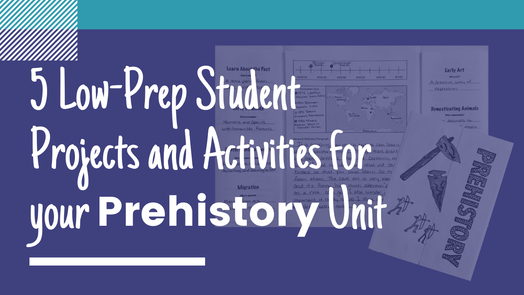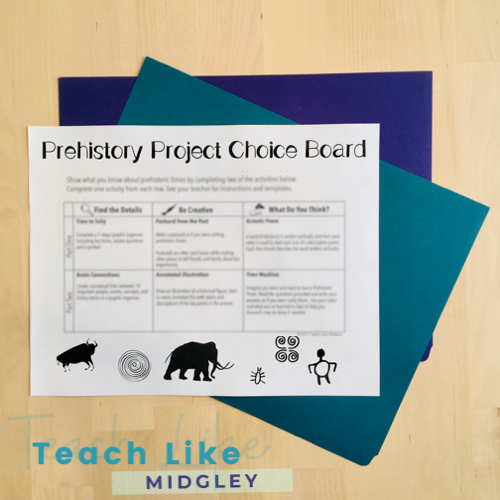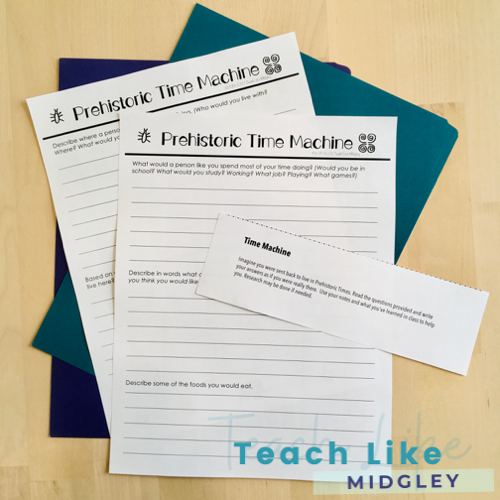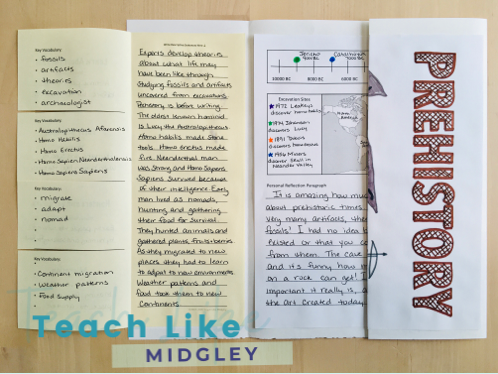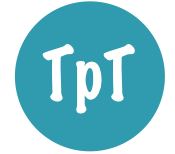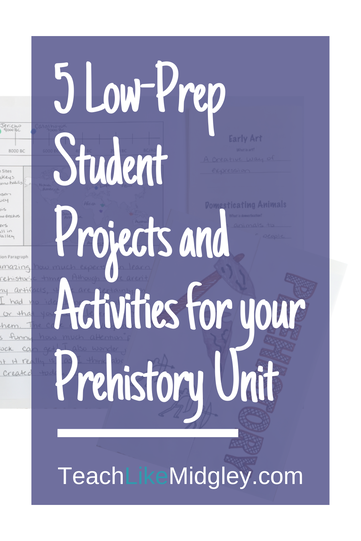5 Low-Prep Student Projects and Activities for your Prehistory Unit
Prehistory is often the first major unit of study for 6th grade ancient civilization curriculum. Which also means it’s studied during the first quarter of the school year.
You are most likely spending a lot of time during that first quarter establishing routines and procedures while setting expectations for the year.
Of course we want our lessons to be fun and engaging, but we can’t dive in too quickly. Our students aren’t ready yet.
You are most likely spending a lot of time during that first quarter establishing routines and procedures while setting expectations for the year.
Of course we want our lessons to be fun and engaging, but we can’t dive in too quickly. Our students aren’t ready yet.
I’ve mentioned before, and I’ll mention again – when I hear teachers talk about starting the school year off with a big project... I cringe.
You want to set your students up for success. Which means easing them in one step at a time. There is so much happening at the start of the school year, your students are likely overwhelmed by it all – especially if this is their first year in middle school.
So you don’t want to throw a big, hands-on project in the mix and add to the chaos.
You also might not be willing to dive in with a group of students you don’t really know yet, either.
Or maybe, you just aren’t into the whole hands-on STEM/STEAM projects. It’s okay if you’re not, it doesn’t make you any less of a teacher. We all have our own comfort zones and level of tolerance for mess and crazy.
So in this post, you’ll learn about 5 activities for your Prehistory unit that will allow you to engage your students, while not going off the deep end into the project world.
The first three are great activities to work in throughout the unit and do something fun that requires students to think a little deeper.
The final two on the list are good, comprehensive activities or projects that are a great cumulative way to bring your unit to a close, and can even be used as assessments.
Activity #1 - Make a Timeline
If you’re teaching ancient civilizations (and I’m assuming you are since here you are reading!) you will no doubt be teaching your students about timelines.
Not sure how to do that? Then check out this post: 5 Lesson Plans for Teaching Timelines
A great activity to help your students develop this skill, is to have them create a timeline of their own life.
An easy adaptation is to have students use their own birth as the center for the timeline. Have them talk to their parents about events that happened before they were born.
For the assignment, require students to include at least 10 events on their timeline. It’s up to them if they want the events to be personal.
Not sure how to do that? Then check out this post: 5 Lesson Plans for Teaching Timelines
A great activity to help your students develop this skill, is to have them create a timeline of their own life.
An easy adaptation is to have students use their own birth as the center for the timeline. Have them talk to their parents about events that happened before they were born.
For the assignment, require students to include at least 10 events on their timeline. It’s up to them if they want the events to be personal.
Activity #2 - Excavation Report
There are lots of important excavation sites and discoveries that have helped experts develop the theories we learn/teach in our lessons.
There are also quite a few new discoveries being made even now, present-day.
Have your students write a brief report of what’s been discovered at a particular excavation site. They can even include their own “theories” based on the evidence uncovered.
You may choose to assign the excavation site or have students pick one from a supplied list. It highly depends on what resources you have available for them to use.
There are also quite a few new discoveries being made even now, present-day.
Have your students write a brief report of what’s been discovered at a particular excavation site. They can even include their own “theories” based on the evidence uncovered.
You may choose to assign the excavation site or have students pick one from a supplied list. It highly depends on what resources you have available for them to use.
Activity #3 - Create a Cave Wall
Don't panic! This is easier than it sounds. Let me assure you, it can be quite structured.
This is actually one of my favorites that gets students thinking. For homework, I have students think about what would be most important to them if they lived 10,000 years ago – and come to class the next day with their answer.
While students read an excerpt about a girl who lived in a cave – Maroo of the Winter Caves – and do their first set of vocabulary work independently, we create our cave wall.
Tape a big piece of brown butcher paper on the front wall. Then bring up students one at a time and have them paint the answer to their homework question while others continue to work.
It’s the most low-key painting project I’ve ever done with students. After all students finish, as a class we talk about the paintings. What they are, what might mean, and it gives students some insight to actual cave paintings and what they tell us.
This is actually one of my favorites that gets students thinking. For homework, I have students think about what would be most important to them if they lived 10,000 years ago – and come to class the next day with their answer.
While students read an excerpt about a girl who lived in a cave – Maroo of the Winter Caves – and do their first set of vocabulary work independently, we create our cave wall.
Tape a big piece of brown butcher paper on the front wall. Then bring up students one at a time and have them paint the answer to their homework question while others continue to work.
It’s the most low-key painting project I’ve ever done with students. After all students finish, as a class we talk about the paintings. What they are, what might mean, and it gives students some insight to actual cave paintings and what they tell us.
#4 - Choice Board Projects with Templates
While I fully support student choice, I also advocate for providing students structure.
Using a simple Choice Board of options for students, it gives them ownership of their project and encourages effort. If your projects options also incorporate different project styles that compliment your students’ strengths, then even better.
My Choice Boards give three different styles of projects.
The first is designed for students who like details. Examine facts, details, use charts and think logically. Investigator projects are designed for students who like to answer questions and find details.
The second is designed for students who are artistically talented. Focus on pictures and create drawings and crafts to share information in a unique way. Creator projects are designed for students who like to share their artistic talents & skills.
And the third is designed for students who are interested in people and how they think. Imagine yourself at a historic event and write about how you would react. Journalist projects present findings in short writings.
But along with giving students choice, they also need structure. Which is why I love templates for students. They provide direction and give them someplace to start – instead of sitting there staring at a blank paper.
Using printer-friendly templates are also very low-prep for teachers.
Then use a rubric for quick grading and you’re done!
Using a simple Choice Board of options for students, it gives them ownership of their project and encourages effort. If your projects options also incorporate different project styles that compliment your students’ strengths, then even better.
My Choice Boards give three different styles of projects.
The first is designed for students who like details. Examine facts, details, use charts and think logically. Investigator projects are designed for students who like to answer questions and find details.
The second is designed for students who are artistically talented. Focus on pictures and create drawings and crafts to share information in a unique way. Creator projects are designed for students who like to share their artistic talents & skills.
And the third is designed for students who are interested in people and how they think. Imagine yourself at a historic event and write about how you would react. Journalist projects present findings in short writings.
But along with giving students choice, they also need structure. Which is why I love templates for students. They provide direction and give them someplace to start – instead of sitting there staring at a blank paper.
Using printer-friendly templates are also very low-prep for teachers.
Then use a rubric for quick grading and you’re done!
#5 - Lap-book Projects
These have quickly become one of my favorites. They provide lots of direction and structure for students. They are easy to grade, and they are very comprehensive. Which makes for a perfect end of the unit project.
We take 4 days to complete the lap-book project. Students are provided a guide sheet, which tells them what steps should be done and when. They start with a graphic organizer that they use to compile what they’ve learned.
Sometimes, it’s helpful to have students work with a partner to compile the information.
Next, students receive their templates and start filling in the information they’ve gathered. With this process, students to the “hard part” first, before they start with project designing. This ensures the important stuff is done first.
After filling in all the templates, they get their large 11x14 inch paper (or old file folder) to glue in their templates.
Then the best is saved for last, designing the cover. Students can then take as much time as they have left for artistic style and design.
The Prehistory lap-book covers all the major concepts of the unit:
+ Archaeology and excavations
+ Early Hominids
+ Hunters & Gatherers
+ Migration
+ Early Art
+ Domesticating Animals
+ Early Agriculture
+ Building Communities
+ Timeline Skills
+ Map Skills
+ Critical Thinking and Reflection
And then again, quick easy grading with a rubric and you’re done.
We take 4 days to complete the lap-book project. Students are provided a guide sheet, which tells them what steps should be done and when. They start with a graphic organizer that they use to compile what they’ve learned.
Sometimes, it’s helpful to have students work with a partner to compile the information.
Next, students receive their templates and start filling in the information they’ve gathered. With this process, students to the “hard part” first, before they start with project designing. This ensures the important stuff is done first.
After filling in all the templates, they get their large 11x14 inch paper (or old file folder) to glue in their templates.
Then the best is saved for last, designing the cover. Students can then take as much time as they have left for artistic style and design.
The Prehistory lap-book covers all the major concepts of the unit:
+ Archaeology and excavations
+ Early Hominids
+ Hunters & Gatherers
+ Migration
+ Early Art
+ Domesticating Animals
+ Early Agriculture
+ Building Communities
+ Timeline Skills
+ Map Skills
+ Critical Thinking and Reflection
And then again, quick easy grading with a rubric and you’re done.
Ready To Roll Materials
So there you have it – 5 easy projects for your study of Prehistory that will get your students thinking, engaging, and demonstrating the important concepts of the unit. All without being overwhelming – for you or the students.
And true to what you’ve come to expect from Teach Like Midgley – I have some of these projects all designed and ready to roll for you!
You can go here to grab my Prehistory Choice Board Projects.
You can go here to grab my Prehistory Lap-book Project.
And if you’re looking for core content to help you with your daily lessons, then be sure to check out the Prehistory Lesson Set Bundle.
And true to what you’ve come to expect from Teach Like Midgley – I have some of these projects all designed and ready to roll for you!
You can go here to grab my Prehistory Choice Board Projects.
You can go here to grab my Prehistory Lap-book Project.
And if you’re looking for core content to help you with your daily lessons, then be sure to check out the Prehistory Lesson Set Bundle.
You May Also Like...
Let's Connect...

Welcome! I'm Hillary Midgley, a veteran 6th grade teacher.
I create educational materials and develop curriculum for other teachers. I specialize in teaching students how to learn through my Study Skills Curriculum. I have established fundamental classroom systems and structures for teachers to help them streamline their classroom. And my passion is teaching ancient history through engaging activities with foundations in academic skills. Here you will find resources on all of these topics and more. Learn more about me here.
|

